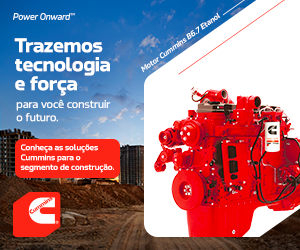Concessionaires advance in the use of NDM
Utilizing non-destructive construction methods (NDMs), companies such as Sabesp and Comgás are proof of how such technologies can be economically attractive for the installation of underground networks

Two public utilities concessionaires in the city of São Paulo, Comgás and Sabesp, demonstrate how the use of non-destructive construction methods (NDM) has literally been gaining ground in the country. In the former (Comgás), over 90% of works for the expansion of gas distribution that were carried out in 2011 utilized the technology. In all, that meant 1,200 km of new distribution network lines according to Laércio Piva, superintendent for network expansion at Comgás.
Until September 2012, the number of networks that were installed was also significant, reaching 918 km. And the forecast was that, by the end of the year, the figure would reach 1,250 km. “NDM technology is very important because it is practical and causes less impact on urban surroundings,” assesses Piva. To him, since year 2000, adoption of the NDM has been very intense and one of the most positive factors in this period was the growth in the number of companies that adopted this technology. Piva argues that the qualification of companies has also grown over the 12 years that his company has been using non-destructive construction method technology.
Evolution
 Lower environmental impact, through reduced production of construction residues, is another aspect that scored points for the technology at Comgás. “There is a fierce difference between the use of non-destructive methods and the conventional digging of trenches,” Piva assures. “Sidewalks are left intact, repairs are reduced to a minimum, and intervention in traffic and in the area surrounding the job site is much lower.”
Lower environmental impact, through reduced production of construction residues, is another aspect that scored points for the technology at Comgás. “There is a fierce difference between the use of non-destructive methods and the conventional digging of trenches,” Piva assures. “Sidewalks are left intact, repairs are reduced to a minimum, and intervention in traffic and in the area surrounding the job site is much lower.”
Piva further reminds us that, prior to the more intensive use of the technology as of the beginning of the 2000s, the methodology was already widely known and used abroad in applications involving smaller networks and using smaller machines when compared to present-day equipment.
The infrastructure of the company’s pipelines includes networks of polyethylene pipes with diameters ranging from 20 mm to 250 mm. The average diameter pipeline however ranges from 63 mm to 125 mm, which enables the use of smaller, more agile Horizontal Directional Drilling (HDD) machines that can easily be moved from one job site to another for deployment. With that, the company expects to add another 1,250 km to its piped gas network in 2013, maintaining the level of use of NDM between 90% and 95% of the total for such works.
All of the companies that are hired to participate in this type of project at Comgás must be qualified; a process that also includes companies that are subcontracted. Besides the management of the project itself, each contractor must prove that it is capable of complying with the sector’s norms. As regards planning, Piva explains that the expansion has been undergoing study for at least 18 months prior to action, which allows the company to assess any interference that may exist at the locations where drilling will be performed.
As standard procedure, the concessionaire elaborates the basic project and participates intensely in the elaboration of the executive project, evaluating the plans for drilling. “No work gets the green light until we have the executive project ready,” Piva explains.
Although the reference data on underground networks that the company receives is not updated continually, the Comgás executive points out that network mapping technologies have also evolved. “We request all the information available on interferences prior to any work and follow up on that information by monitoring the work in the field to confirm the data,” Piva explains.
Each project being executed is inspected and monitored by the concessionaire whose staff makes technical visits to the site to validate the drilling plan. At the end of implementation, updated documentation is elaborated to serve as a base of reference for other expansions.
Pioneer
 Likewise as in Comgás, Sabesp also adopts NDM technology. Sabesp - the concessionaire of water and sanitation services - estimates that 60% of the 564 works underway in the execution of ‘Projeto Tietê’, for example, are already utilizing non-destructive methods. The objective of Project Tietê is to improve the quality of streams through the implementation of wastewater collectors and interceptors in the system, increasing the amount of waste that is collected and treated. “Sabesp is a pioneer in the use of NDM in Brazil, which the company has been adopting since the 1970s,” points out Flávio Durazzo, a member of Sabesp’s staff of engineers. “Without the use of non-destructive technology, the city of São Paulo would simply come to a halt.”
Likewise as in Comgás, Sabesp also adopts NDM technology. Sabesp - the concessionaire of water and sanitation services - estimates that 60% of the 564 works underway in the execution of ‘Projeto Tietê’, for example, are already utilizing non-destructive methods. The objective of Project Tietê is to improve the quality of streams through the implementation of wastewater collectors and interceptors in the system, increasing the amount of waste that is collected and treated. “Sabesp is a pioneer in the use of NDM in Brazil, which the company has been adopting since the 1970s,” points out Flávio Durazzo, a member of Sabesp’s staff of engineers. “Without the use of non-destructive technology, the city of São Paulo would simply come to a halt.”
The extensive experience of Sabesp can also be found by the information provided by Abiathar de Oliveira Castro of the Santo Amaro District’s Regional Management Unit in São Paulo, who offered details on operations undertaken by the concessionaire in the specific and localized application of ‘Cured-in-Place Pipe’ (CIPP) technology for the recovery of water networks. According to Oliveira Castro, the process was applied to ceramic pipes installed to 2.38 m in depth. “And the sites where the operation intervened have a high volume of traffic, not to mention the presence of a high school besides,” he says.
Following technical diagnostics to detect problems in the pipeline, including a visual inspection of the inner pipe, the concessionaire chose the methodology of cleaning and the adoption of CIPP, with the application of a resin, in a process that took nine minutes. Curing of the material, in turn, took a total 82 minutes, which meant an average time of one to two hours required to perform this step.
With the application of NDM, the intervention by Sabesp at the site took no longer than three hours - including the steps involved in the placement of signage, diagnostics, cleaning and rehabilitation of the pipeline. As a result, the work dispensed with digging of trenches, did not produce any construction residues or debris and, mainly, caused minimal interference to traffic in the region.

Av. Francisco Matarazzo, 404 Cj. 701/703 Água Branca - CEP 05001-000 São Paulo/SP
Telefone (11) 3662-4159
© Sobratema. A reprodução do conteúdo total ou parcial é autorizada, desde que citada a fonte. Política de privacidade















